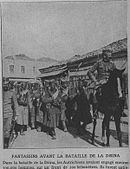 | ||
approximately 17,000 dead & wounded approximately 18,500 dead & wounded Period September 1914 – 4 October 1914 Result Serbians conduct limited offensive action, Austrians establish bridgeheads Similar World War I, Battle of Cer, Battle of Kolubara, 1914 Serbian Campaig, Serbian army's retreat thr | ||
The Battle of Drina (Serbian: Битка на Дрини, Bitka na Drini) was fought between the Serbian and Austro-Hungarian armies in September 1914, during World War I. The Austro-Hungarians engaged in a significant offensive over the Drina river at the western Serbian border, resulting in numerous skirmishes (the Battle of Mačkov Kamen and the Battle of Gučevo being the heaviest ones). In early October, the Serbian Army was forced to retreat, and later regrouped to fight in the subsequent Battle of Kolubara.
Contents
Prelude
After being defeated in the Battle of Cer in August 1914, the Austro-Hungarian army retreated over the Drina river back into Bosnia and Syrmia. Under pressure from its allies, Serbia conducted a limited offensive across the Sava river into the Austro-Hungarian region of Syrmia. Meanwhile, the Timok First Division of the Serbian Second Army suffered a heavy defeat in a diversionary crossing, suffering around 6,000 casualties while inflicting only 2,000.
With most of his forces in Bosnia, general Oskar Potiorek decided that the best way to stop the Serbian offensive was to launch another invasion into Serbia to force the Serbs to recall their troops to defend their much smaller homeland.
The offensive
September 7 brought a renewed Austro-Hungarian attack from the west, across the river Drina, this time with both the Fifth Army in Mačva and the Sixth Army further south. The initial attack by the Fifth Army was repelled by the Serbian Second Army, with 4,000 Austro-Hungarian casualties, but the stronger Sixth Army managed to surprise the Serbian Third Army and gained a foothold into Serbian territory. After some units from the Serbian Second Army were sent to bolster the Third, the Austro-Hungarian Fifth Army also managed to establish a bridgehead with a renewed attack. At that time, Field Marshal Radomir Putnik withdrew the First Army from Syrmia (against much popular opposition) and used it to deliver a fierce counterattack against the Sixth Army that initially went well, but finally bogged down in a bloody four-day fight for a peak of the Jagodnja mountain called Mačkov Kamen, in which both sides suffered horrendous losses in successive frontal attacks and counterattacks. Two Serbian divisions lost around 11,000 men, while Austro-Hungarian losses were probably comparable.
Field Marshal Putnik ordered a retreat into the surrounding hills and the front settled in a month and a half of trench warfare, which was highly unfavourable to the Serbs, who possessed heavy artillery that was largely obsolete, had short ammunition stocks, limited shell production (having only a single factory producing around 100 shells a day) and also a lack of proper footwear, since the vast majority of infantry wore the traditional (though state-issued) opanaks, while the Austro-Hungarians had soak-proof leather boots. Most of the war material was supplied by the Allies, who were short themselves. In such a situation, Serbian artillery quickly became almost silent, while the Austro-Hungarians steadily increased their fire. Serbian daily casualties reached 100 soldiers from all causes in some divisions.
During the first weeks of trench warfare, the Serbian Užice Army (one strengthened division) and the Montenegrin Sanjak Army (roughly a division) conducted an abortive offensive into Bosnia. In addition, both sides conducted a few local attacks, most of which were soundly defeated.
